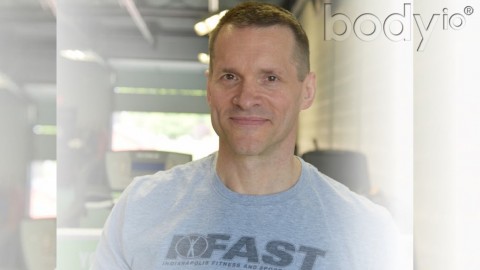To find out more about Monte Spicer’s X-Frame series, read the introductory article here.
To build your X-Frame physique, we have to take advantage of angles. When you train any body part, the goal is to hit it from every conceivable angle. Doing things this way accomplishes two things: It creates the illusion of balance in your muscles, making you look bigger, and it promotes structural balance within all your muscle groups—which makes you stronger and helps you avoid injury.
Today, we’re starting your X-Frame from the top—with your shoulders. The next time you’re in the gym, take a look at some of the people around you. Stand in front of them, and examine their shoulder development from the front. Some people look square, and some look like they’re round, right? Most guys have shoulders shaped like coat hangers—and that’s not the shape we want, because that’s a square look. We’re aiming for round shoulders with this program, so by training at multiple angles, we’ll get rid of all that square shit and round you off in a hurry.
Stop Being a Pussy and Do More Reps
I’m going to suggest something a little bit counterintuitive here with regard to the number of reps you do with each set. Instead of working up pyramid-style, or dropping the reps as the weight gets heavier, I want you to increase the number of reps you perform as you add weight to the bar (or move to heavier dumbbells). If you don’t increase the weight you’re using on a particular exercise, increase the number of reps you do on your next set with the same weight.
The rule? One more rep with each set.
Don’t drop down in weight. You don’t want to do this, because the whole idea here is to manufacture a way to keep your intensity high—and by intensity, I’m talking about your focus, and not percentages of your one-rep max. If you’re training by yourself, this will keep you focused on hitting a bigger number than you ordinarily would, with every set you do.
This won’t give you those self-imposed breaks where you’re saying, “Hey, this is gonna be easy. I only have to do five reps on this set.” Instead of doing that, make it twelve, and really engorge your muscles with blood. It’ll take a bit of trial-and-error to figure out the weights you’ll be able to handle with this method, but you’ll notice a difference in the intensity of your workouts immediately.
Pick Up the Pace
I want you to train at a fast pace with short rest periods here—60 seconds or less. The less you rest, the more blood you can get into your muscles—and when you have that great pump in your shoulders, you can produce more growth. The idea is to train your shoulders faster than you would with other muscle groups. They’ll recover more quickly because they’re already trained to do so through everyday use.
If you’re training by yourself, use a stopwatch to time your rest periods. If you don’t have a stopwatch, use my “fake-ass partner” trick. I got so used to training with partners on the you-go-I-go system over the years that I like training that way by myself, too. I’ll stare at the bar and count reps as though my training partner is lifting, and once “he’s” done, I’ll do my set. Whichever method you choose, just keep things moving.
Warming Up
I like to vary the order of my workouts, which I’ll explain later on in terms of what this means for your warm-up. For now, just understand that it’s absolutely essential to give yourself a comprehensive warm-up before doing any shoulder work.
There are several different things that will accomplish this purpose nicely. I like starting out with some pendulum dumbbell work. Take a pair of light dumbbells and swing them back and forth and side to side—working in some rotational movements, too. Do this for a while until you feel your range of motion increasing. From here, I’ll set a cable attachment to a very light weight and do some rotator cuff work. Don’t just run through these moves quickly. Take the time to work these light exercises until your shoulders actually feel warm enough to start pressing.
The Exercises
SEATED BARBELL MILITARY OR SMITH MACHINE PRESS
This is the “meat and potatoes” move of all shoulder exercises—the king of all mass-builders. If I’m pressing at the beginning of my exercise order, I’ll use the Smith machine, keeping my hands at shoulder width (put your thumbs at the edge of the barbell’s knurling, extend them with your palms flat, and grip the bar from there). If I’ve reversed the order and I’m doing this at the middle or end of my workout, I’ll use free weight on the seated military bench. At the start of a workout, you’re more susceptible to injury, and since I’ve never been on the anti-Smith machine bandwagon, this is a great time to work it in if your gym has one.
Believe it or not, I like behind-the-neck pressing, too. I know this one is a pariah in some circles because of the supposed risk of injury it carries, but if you know what you’re doing, you’re not going to get hurt. I’ve been doing these forever, and so has every bodybuilder I know with well-developed (and healthy) shoulders. Alternate your sets with these, doing front-rear-front-rear for a total of 4-5 working sets.
A word about Smith machine technique:
When you use the Smith machine for overhead pressing, you don’t have to sit directly under the bar. Instead, scoot your ass back a few inches, keeping your back straight. This will put the bar out in front of you a little bit more than you’re accustomed to. It’s a technique that will better isolate your shoulders so they’re bearing most of the load—which, in turn, will keep them firing throughout the set.
REAR DELT RAISE ON INCLINE BENCH
For these, maneuver your body down low enough so your forehead is on the back pad of the bench. I’ll start off with 30 pound dumbbells for a set of 10-12 reps, then work up in ten pound increments—using 40, 50, and 60 for 4-5 total sets. Again, increase the number of reps you do by one with each set. This will engorge your muscles with blood and force your body to work. When all you’re doing is concentrating on the number of reps you need—and that number is a major challenge—you’ll strengthen your mind-muscle link and stimulate muscle growth like crazy.
SIDE LATERALS
The correct way to do these is as a partial movement. Biomechanically, your deltoids engage for about 15 percent of this movement, so if you come partially up, you’ll totally isolate them instead of bringing your traps into play. Cut down your typical range of motion, and use more weight.
FRONT RAISES
Instead of taking the dumbbells to forehead level, go all the way up the finish position of a locked-out shoulder press. You’ll have to work with lighter weights here, because this puts a great deal of stress on your shoulders. The payoff, however, is well worth it. This exercise will give you the flexibility you’ll need to lock in your shoulders with overhead movements like military presses and Olympic lifting, while working your “deceleration muscles” with a longer-than-usual eccentric portion.
Workout Chart
You may be looking at this list, thinking, “That’s it?” Think about it, though. If you’re doing 4-5 sets of each exercise, with the intensity and volume ascending with each set, you’re putting in 16-20 very difficult sets for one body part. You don’t need any more than that. When you hit an advanced level with a routine like this, we can start adding other exercises, but this should give you plenty of volume from a variety of angles.
1. SEATED BARBELL MILITARY PRESS: 2-3 warm-up sets, followed by 4-5 sets, increasing weight with each set, of 10-15 reps (with one more rep on each set).
2. REAR DELT RAISE ON INCLINE BENCH: 4-5 sets, increasing weight with each set, of 10-15 reps (with one more rep on each set).
3. SIDE LATERALS (PARTIAL): 4-5 sets, increasing weight with each set, of 10-15 reps (with one more rep on each set).
4. FRONT RAISES (ALL THE WAY UP): 4-5 sets, increasing weight with each set, of 10-15 reps (with one more rep on each set).












